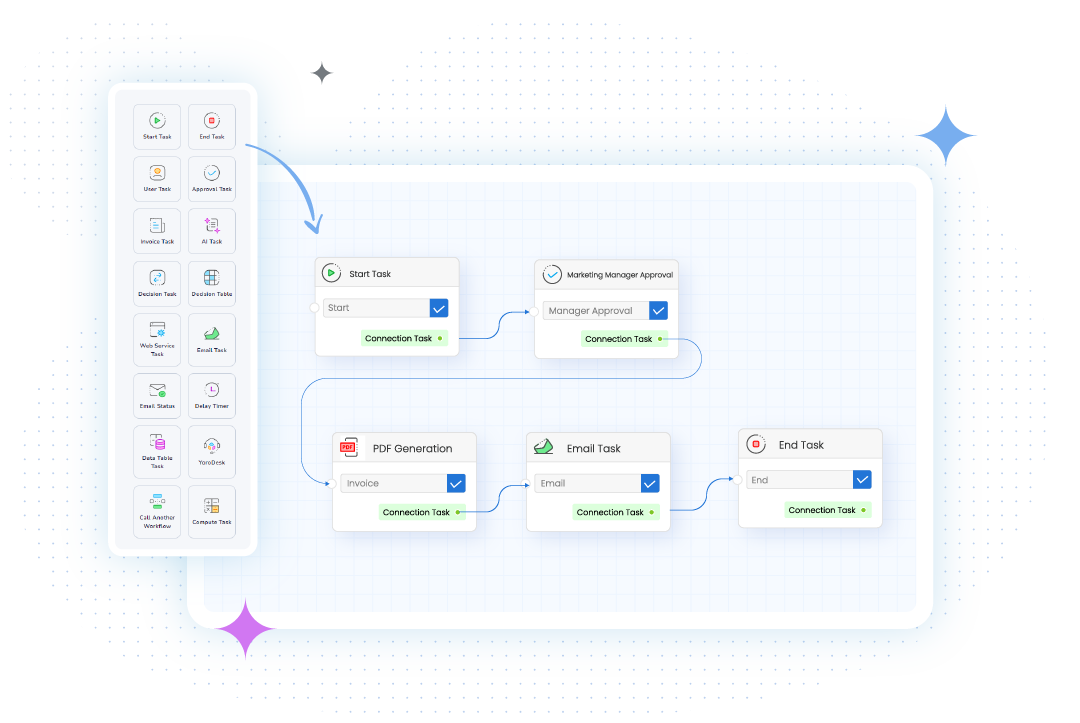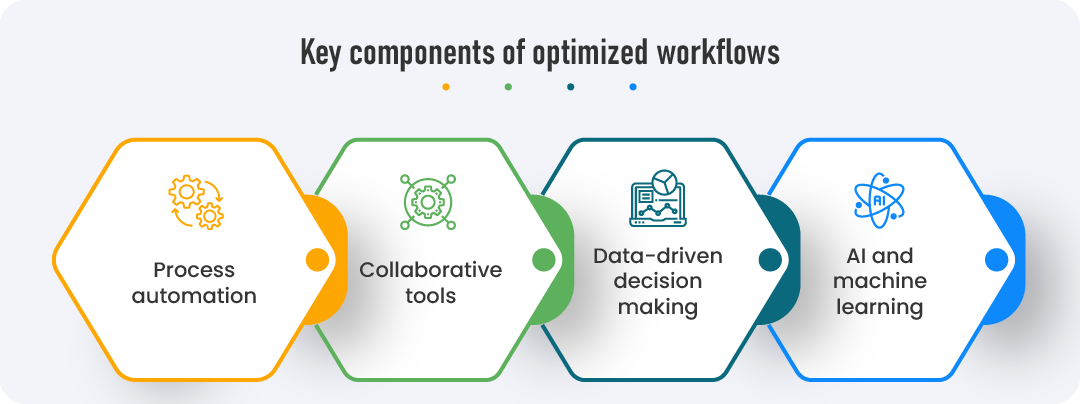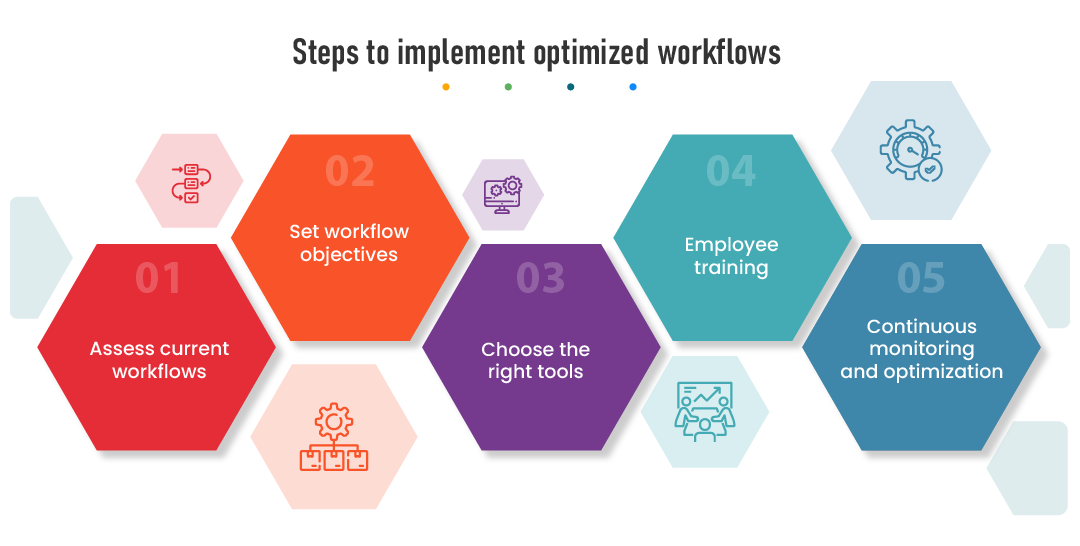Let's start,
- Introduction
- Challenges without optimized workflows
- Technological transformation
- Definition of Optimized Workflow
- Key components of optimized workflows in a digital workplace
- Steps to implement optimized workflows
- The future of workflows in the digital workplace
- Yoroflow’s Capabilities in Digital Workflow Management
- How Yoroflow Automates Tasks, Fosters Collaboration, and Improves Efficiency
- Yoroflow in Action
- Final thoughts
Introduction
The digital workplace has undergone a significant transformation in recent years, shifting from traditional office environments to more flexible, remote, and hybrid models. This shift, driven by advancements in technology such as cloud computing, collaboration tools, and automation, has empowered organizations to operate beyond physical boundaries. However, with these new opportunities come challenges, particularly around managing workflows, ensuring team collaboration, and maintaining productivity across dispersed teams.
In this evolving landscape, optimized workflows are crucial for businesses to remain agile and efficient. Unoptimized processes can lead to delays, communication breakdowns, and decreased productivity, making it difficult for teams to meet deadlines and align on objectives. By implementing streamlined, technology-driven workflows, organizations can overcome these challenges, improving coordination, minimizing errors, and boosting overall performance.
This whitepaper explores the importance of optimized workflows in the digital workplace, offering insights into the key technologies driving this transformation and actionable steps for implementing efficient processes to thrive in today's fast-paced business environment.

The digital workplace landscape
The workplace has evolved dramatically over the past decade, moving from traditional office setups to remote, hybrid, and digital-first models. Technologies like cloud computing, collaboration tools, and mobile platforms allow teams to work from anywhere. While this shift offers flexibility and access to global talent, it also increases the complexity of managing distributed teams, data, and cross-functional projects. The need for optimized workflows has become critical to manage the growing demands of the digital workplace.
Unoptimized workflows often lead to inefficiencies such as communication breakdowns, missed deadlines, and lost productivity. Without streamlined processes, teams struggle with manual tasks, duplicated efforts, and delays in project progress. The lack of clear workflow systems can make collaboration difficult, hindering overall performance.
Challenges without optimized workflows
Without optimized workflows, businesses encounter several challenges that significantly hinder productivity, efficiency, and overall performance. One of the most prominent issues stems from manual processes, which are often time-consuming and prone to errors. Tasks such as data entry, approval workflows, and email-based communications require human intervention, making them slower and susceptible to mistakes. These delays can lead to missed deadlines, increased operational costs, and poor customer satisfaction. In the fast-paced digital age, businesses that rely on manual processes struggle to meet the expectations of speed and accuracy that both customers and stakeholder's demand.
Another issue is the burden of repetitive tasks on employees, which prevents them from focusing on higher-value activities. For instance, employees might spend considerable time on administrative work rather than contributing to strategic projects, limiting innovation and growth. This not only reduces team morale but also hampers the organization's ability to stay competitive.
Perhaps one of the most critical challenges is the lack of visibility into workflow progress. Without proper tracking systems, managers and teams have little insight into the status of ongoing projects, resource allocation, or potential bottlenecks. This lack of transparency makes it difficult to adjust priorities, reallocate resources, or resolve issues in a timely manner. As businesses grow and become more complex, managing workflows across departments and teams becomes increasingly challenging, leading to miscommunication, misaligned goals, and inefficient collaboration. Ultimately, the absence of optimized workflows diminishes productivity, disrupts business continuity, and negatively affects long-term success.
Technological transformation
Modern technologies like AI, machine learning, and automation are revolutionizing workflows. AI-driven tools can automate routine tasks, analyze data, and offer insights for optimizing processes. Automation reduces manual workload, minimizes errors, and ensures seamless data integration across systems. These advancements help businesses create agile, efficient, and scalable workflows, enabling them to thrive in the increasingly complex digital landscape
Yoroflow plays a vital role in this technological transformation, serving as a comprehensive digital workflow management platform that integrates these advanced technologies. By automating routine processes and providing real-time insights, Yoroflow enables organizations to streamline operations and enhance collaboration among teams. With its user-friendly interface and customizable features, Yoroflow allows businesses to adapt workflows to their unique needs, ensuring they remain agile and competitive in today’s fast-paced digital landscape.
Definition of Optimized Workflow
An optimized workflow refers to a streamlined and efficient process that minimizes redundancies and maximizes productivity across tasks and departments. It involves analyzing and refining existing workflows to eliminate bottlenecks, reduce manual effort, and enhance communication among team members. Optimized workflows leverage automation, technology, and best practices to ensure that tasks are completed more quickly and accurately, resulting in increased efficiency and reduced operational costs.
Yoroflow plays a crucial role in optimizing workflows by providing a comprehensive digital workplace solution. With its advanced features for process management, task automation, and real-time collaboration, Yoroflow enables organizations to create custom workflows tailored to their specific needs. By integrating various tools and automating routine tasks, Yoroflow not only enhances productivity but also fosters better alignment between teams, allowing them to focus on innovation and strategic initiatives rather than getting bogged down by repetitive processes.
Key components of optimized workflows in a digital workplace

Process automation:
Automating repetitive tasks, such as data entry, approvals, and routine updates, is a fundamental aspect of optimized workflows. By implementing automation, organizations can significantly improve accuracy and minimize human error, leading to more reliable outcomes. Automation also accelerates project timelines by streamlining processes and allowing teams to focus on higher-value tasks instead of mundane activities.
Collaborative tools:
Digital tools, such as project management software, communication platforms, and document-sharing systems, play a vital role in enhancing team collaboration, especially in remote and hybrid work environments. These tools enable seamless communication and information sharing among team members, fostering a collaborative culture that drives innovation and efficiency. By providing a centralized platform for project tracking and updates, teams can work more cohesively and reduce the chances of miscommunication
Data-driven decision making:
Real-time data insights, dashboards, and reports empower organizations to make informed decisions quickly. With access to relevant metrics, teams can identify bottlenecks, assess workflow efficiency, and monitor overall performance, enabling proactive adjustments that optimize outcomes.
AI and machine learning:
AI and machine learning technologies offer significant potential for workflow optimization. These tools can predict workload distribution, automate complex decision-making processes, and enhance productivity by analyzing data patterns. By integrating AI and ML, organizations can create adaptive workflows that respond dynamically to changing conditions, ensuring optimal performance in the digital landscape.
Steps to implement optimized workflows

Assess current workflows:
The first step in implementing optimized workflows is to audit existing processes. Organizations should conduct a thorough analysis of current workflows to identify bottlenecks and inefficiencies. This involves mapping out each step of the workflow, gathering feedback from team members, and documenting areas where delays occur, or tasks are duplicated. By understanding the current state, organizations can pinpoint specific pain points that need addressing.
Set workflow objectives:
After assessing workflows, organizations should define clear, measurable goals for optimization. For example, objectives may include reducing task completion time by 20% or increasing cross-team collaboration. Setting SMART (Specific, Measurable, Achievable, Relevant, Time-bound) goals provides a framework for evaluating success and ensures that everyone is aligned on the desired outcomes
Choose the right tools:
Selecting the appropriate workflow management software is crucial. Organizations should evaluate potential tools based on criteria such as customization options, ease of integration with existing systems, scalability, and user-friendly interfaces. The right tools should enhance efficiency without causing additional complexity.
Employee training:
Proper training is vital for the successful adoption of new workflow tools. Organizations should invest in comprehensive training programs to educate employees on new processes and technologies. This support helps facilitate smoother transitions and encourages staff to embrace the changes.
Continuous monitoring and optimization:
Finally, ongoing monitoring of workflow performance is essential. Organizations should track key metrics to evaluate the effectiveness of implemented changes and identify areas for further improvement. This continuous optimization cycle ensures that workflows remain efficient and aligned with evolving business needs.
The future of workflows in the digital workplace
The future of workflows in the digital workplace is poised for significant transformation, driven by advancements in AI, cloud computing, and the Internet of Things (IoT). These technologies will enable increased automation, allowing organizations to streamline operations further and enhance real-time monitoring and advanced analytics. For instance, AI algorithms can analyze workflow data to dentify inefficiencies, while IoT devices can provide instant feedback on process performance.
As remote and hybrid work trends continue to rise, the demand for flexible, digital-first workflows will become even more critical. Organizations will need to implement solutions that support productivity and collaboration among dispersed teams, ensuring that all employees can work effectively regardless of their location.
Looking ahead, experts predict that emerging technologies will redefine workflow management, fostering seamless integration across tools and departments. This evolution will empower organizations to enhance collaboration, improve operational efficiency, and deliver greater value to customers, positioning them for success in an increasingly dynamic business landscape.
Yoroflow’s Capabilities in Digital Workflow Management
Yoroflow is a powerful digital workflow management tool designed to help organizations streamline processes, automate routine tasks, and enhance collaboration across teams. As a low-code/no-code platform, Yoroflow allows users to design and implement custom workflows with minimal technical expertise, making it accessible for organizations of all sizes and industries. The platform is flexible and scalable, enabling businesses to tailor workflows to their unique operational needs and adapt them as their requirements evolve.
Some of Yoroflow’s key capabilities include:
Workflow Automation:
Yoroflow automates repetitive, manual tasks such as data entry, document approvals, and notifications, reducing the likelihood of human error and saving valuable time.
Process Management:
The platform provides a comprehensive set of tools to manage complex business processes, enabling teams to define, track, and optimize workflows across departments.
Real-Time Collaboration:
Yoroflow integrates with a wide range of communication and project management tools, fostering seamless collaboration among remote or geographically distributed teams.
Task and Project Tracking:
Yoroflow offers built-in task management features, allowing teams to monitor project timelines, assign responsibilities, and receive updates in real time.
Data Integration and Reporting:
The platform enables integration with various data sources and systems, offering real-time analytics, insights, and reporting to help organizations make informed decisions quickly.
Customizable Dashboards:
Yoroflow allows users to create personalized dashboards that provide a centralized view of ongoing workflows, bottlenecks, and key performance metrics, helping teams stay on track and aligned.
With these features, Yoroflow empowers organizations to eliminate inefficiencies, reduce operational costs, and improve the overall flow of tasks and information within the digital workplace.
How Yoroflow Automates Tasks, Fosters Collaboration, and Improves Efficiency
Yoroflow’s automation capabilities are at the heart of its workflow optimization benefits. By automating routine tasks such as approvals, notifications, and document routing, Yoroflow eliminates the need for manual intervention, which not only reduces human errors but also significantly accelerates project timelines. For example, with Yoroflow’s rule-based automation, tasks can be triggered automatically based on predefined conditions, allowing for faster decision-making and process completion.
In addition to automation, Yoroflow facilitates seamless collaboration among teams, especially in today’s remote and hybrid work environments. Its integrations with popular project management and communication tools, such as Microsoft Teams, Slack, and Google Workspace, enable employees to collaborate in real time, share documents, and communicate without leaving the platform. Yoroflow’s centralized platform ensures that all team members have access to the same information and are working towards shared goals, reducing the chances of miscommunication or duplicated efforts.
Yoroflow also improves operational efficiency by providing transparency into workflows and real-time updates on task progress. This enables managers to identify bottlenecks early, redistribute workloads, and make data-driven adjustments to ensure projects stay on track. The platform’s reporting tools offer detailed insights into the performance of workflows, helping organizations identify areas for further improvement and ensuring continuous optimization.
Yoroflow in Action
Several organizations across different industries have successfully implemented Yoroflow to optimize their workflows and improve operational efficiency. Below are some real-world examples of how Yoroflow has made a tangible impact:
Healthcare Providers:
The healthcare providers were struggling with the manual processing of patient forms, approvals, and compliance checks, leading to delays and errors in patient care. By implementing Yoroflow’s workflow automation, the providers could automate the entire form submission and approval process. The system automatically routed patient information to the appropriate department, reducing manual handoffs and the risk of errors. As a result, the healthcare provider improved patient care timelines by 30%, enhanced data accuracy, and ensured regulatory compliance through automated audit trails.
Financial Services Firms:
Financial services firms use Yoroflow to streamline its onboarding and document approval processes. Before using Yoroflow, these firms relied on manual approvals and paper-based processes, which led to significant delays in onboarding new clients. With Yoroflow’s automation and workflow management tools, these firms created a fully automated client onboarding process that integrated document verification, approvals, and digital signatures. This not only reduced onboarding time by 50% but also improved compliance and reduced administrative overheads.
Manufacturing Companies:
Various leading manufacturing companies faced challenges with coordinating production schedules and approvals across multiple departments and locations. Using Yoroflow, those companies were able to automate production requests, approvals, and progress tracking in real time. Yoroflow’s customizable dashboards gave managers visibility into the status of production tasks, and the automation reduced the time it took to move from one stage of the production process to the next. These companies saw a 25% improvement in production efficiency and a reduction in costly delays caused by miscommunication or manual errors.
Educational Institutions:
Educational institutions were facing challenges in managing the workflows associated with course approvals and faculty assignments. The institutions deployed Yoroflow to automate the entire workflow, from course proposal submission to faculty assignment and approval by academic departments. This helped the institutions reduce administrative workload, improve communication between departments, and ensure that all processes were completed within the academic deadlines. These educational institutions saw improved coordination and a 20% reduction in the time it took to approve and assign courses.
Final thoughts
Yoroflow stands out as a powerful tool in this transformation, offering comprehensive workflow automation that integrates seamlessly with existing systems. By leveraging Yoroflow’s capabilities, organizations can automate repetitive tasks, enhance collaboration across teams, and gain real-time insights into their operations. As the future of work evolves, adopting such innovative solutions will empower organizations to optimize their workflows, drive operational excellence, and ultimately deliver exceptional value to their customers. Embracing these advancements is not just a choice; it’s a strategic imperative for success in the digital era.
Yoroflow’s AI-Powered No-Code/Low-Code Platform
Yoroflow delivers AI-powered solutions designed to enhance productivity and streamline workflow processes. Renowned for its advanced features, Yoroflow boosts team efficiency by automating repetitive tasks, utilizing intelligent data insights, and simplifying complex workflows. It offers a comprehensive platform that supports task management, project management, document processing, ticketing systems, customer relationship management, and seamless integrations. By focusing on driving efficiency and fostering collaboration, Yoroflow empowers businesses to achieve more in less time with its no-code/low-code technology.